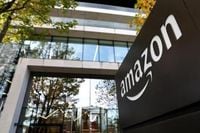On October 29, 2025, Amazon stunned the business world by announcing the elimination of roughly 14,000 corporate jobs—its largest white-collar layoff in recent years—as the company pivots to embrace artificial intelligence and automation at every level. The move, which represents about 4% of Amazon’s global office-based workforce, marks a dramatic shift in how the tech giant sees its future and signals a broader transformation rippling through the entire retail sector.
For many of the affected employees, the news arrived not in a face-to-face meeting or even a phone call, but through a pair of impersonal early-morning text messages. According to Business Insider, these texts urged workers to check their emails before coming to the office—an effort to prevent laid-off staffers from discovering too late that their security badges no longer worked. A second message directed anyone who hadn’t received an email to call a help desk, underscoring the scale and urgency of the operation. Amazon declined to comment on the specifics of its notification process, but the abruptness of the communication has drawn criticism and left many employees reeling.
The layoffs, which hit teams across human resources, devices, services, and operations, are part of a months-long review of priorities and resources. Beth Galetti, Amazon’s senior vice president of people experience and technology, explained in a memo that the cuts are designed to “reduce bureaucracy” and “remove organizational layers.” She added, “While this will include reducing in some areas and hiring in others, it will mean an overall reduction in our corporate workforce of approximately 14,000 roles.” Impacted employees have the opportunity to seek new roles internally; otherwise, they will receive severance pay, outplacement services, and health benefits.
But the story doesn’t end there. According to Reuters, Amazon is reportedly planning to slash up to 30,000 corporate jobs—about 9% of its global office staff—over the coming weeks, with another round of cuts expected in January 2026, after the busy holiday shopping season. If realized, this would represent the largest restructuring in Amazon’s history, exceeding the 27,000 jobs cut in 2023.
Amazon’s CEO, Andy Jassy, has been candid about the forces driving these changes. In a June memo, he urged employees to “embrace automation and help us reinvent the company,” acknowledging that new technology could create new job opportunities but would also bring “efficiency gains” by reducing the overall workforce. “We will need fewer people doing some of the jobs that are being done today,” Jassy wrote. This sentiment was echoed in a company-wide message earlier this year, where he pointed to generative AI’s growing role in planning, analytics, and forecasting—areas once the exclusive domain of human managers.
The timing of these layoffs is especially notable. According to the employment advisory firm Challenger, Gray & Christmas, retail job losses are running three times ahead of last year’s pace through September. The firm reports that retailers have cut 86,233 jobs through September 2025—a staggering 203% increase from the same period in 2024. Across all sectors, U.S. employers have announced nearly one million job cuts so far in 2025, the highest year-to-date total since 2020. Of those, over 17,000 were explicitly attributed to artificial intelligence and another 20,000 tied to automation and technological updates.
“It’s very likely job cut plans are going to surpass a million for the first time since 2020,” wrote Andy Challenger, senior VP at Challenger, Gray & Christmas, in an October report. He compared the current wave of layoffs to previous periods of economic upheaval or significant technological change, such as the automation-driven job losses in manufacturing and technology during 2005 and 2006.
Amazon, long known for pioneering warehouse automation, now finds itself at the forefront of white-collar disruption. The company has already embraced robots and automation in its warehouses, and according to a New York Times report, it plans to avoid hiring more than 600,000 warehouse employees in the coming years thanks to new technology—even as it expects to sell twice as many items. Amazon called that article “an incomplete and misleading picture of our plans,” but the company’s actions speak volumes. In its most recent quarter, Amazon reported $18 billion in profit and ramped up spending on AI data centers, with capital expenses expected to exceed $120 billion in 2025—up nearly 50% from the previous year.
Gartner analysts estimate that by 2026, one in five organizations will use AI to eliminate at least half of their management layers. The implications for the traditional career ladder are profound, especially for younger workers hoping to climb the ranks. Federal Reserve Chair Jerome Powell warned in September 2025 about a “noticeable” slowdown in hiring, particularly for early-career employees. The economy, he said, has entered a “low-hire, low-fire” phase, where companies are reluctant to add jobs even as growth continues. Airbnb CEO Brian Chesky summed up the mood in a Wall Street Journal interview: “If people are getting more productive, you don’t need to hire more people. I see a lot of companies preemptively holding the line, forecasting, and hoping that they can have smaller workforces.”
Amazon isn’t alone in this wave of corporate restructuring. Target, another retail behemoth, announced plans to eliminate 1,800 corporate jobs and close 800 open positions—about 8% of its corporate workforce. The company’s new CEO, Michael Fiddelke, cited “too many layers and overlapping work” as a drag on decision-making, but deeper issues—such as declining sales, controversial cultural decisions, and eroding employee morale—have also played a role. Carter’s, the children’s apparel company, is letting go of 300 corporate staffers (15% of its white-collar workforce) and closing 150 underperforming stores, blaming rising tariffs for the forced cost-cutting.
The broader trend is unmistakable: as AI becomes more capable of handling routine administrative and managerial tasks, companies across the economy are flattening their hierarchies and finding ways to do more with less. Microsoft recently published a study showing that office and administrative support, business and financial operations, management, and sales-related jobs are among the top occupations most at risk of being replaced by AI. Walmart CEO Doug McMillon didn’t mince words at a recent workforce conference: “It’s very clear that AI is going to change literally every job. Maybe there’s a job in the world that AI won’t change, but I haven’t thought of it.”
As the dust settles, many will debate whether these changes represent progress or peril. What’s clear is that the age-old promise of technology—greater efficiency, more innovation, and new opportunities—comes with a human cost. For the 14,000 Amazon employees learning of their fate via text, and the tens of thousands more across the industry facing uncertain futures, that cost is all too real.





